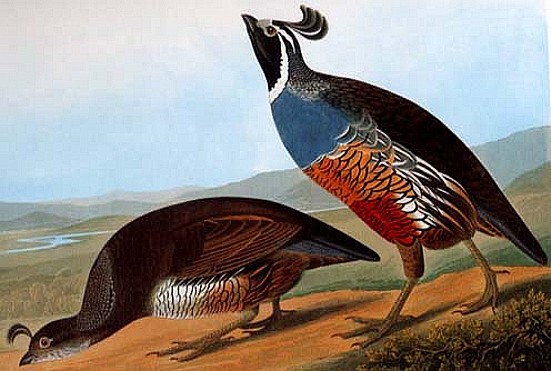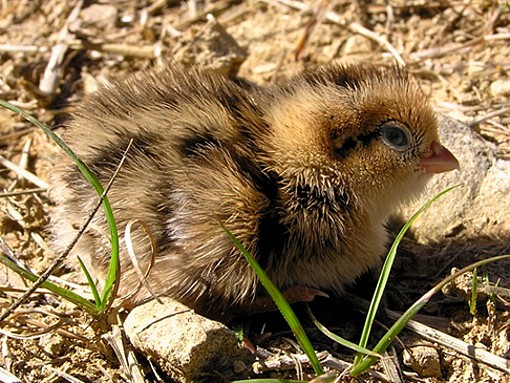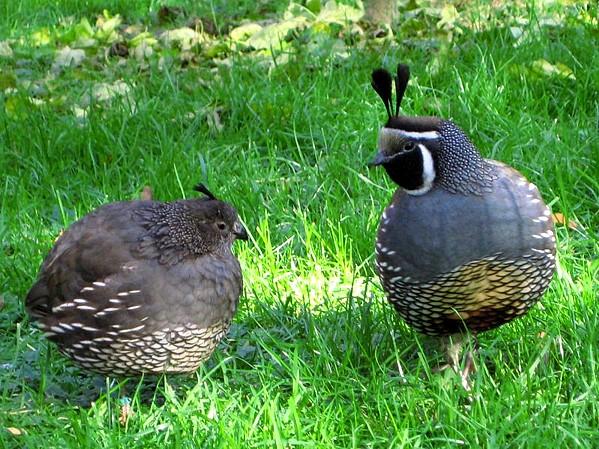Lessico
Quaglia della California
Callipepla californica

La Quaglia della California – Lophortyx californica ribattezzata Callipepla californica, famiglia Fasianidi tribù Odontoforini – è diffusa soprattutto nei boschi di querce e di latifoglie che coprono le vallate e le pendici montane delle regioni nordamericane affacciate sul Pacifico. In molte zone questi uccelli si sono perfettamente adattati al nuovo ambiente agricolo creato dall'uomo, diffondendosi in vigneti, giardini e parchi, e anche nelle grandi città. Per questa loro spiccata capacità di adattamento, le Quaglie della California sono state introdotte con successo in molti altri Stati, ad esempio nell'Utah, nel Nuovo Messico, nella Columbia Britannica, nelle Hawaii, in Nuova Zelanda e nel Cile.
Le grida maschili risuonano con particolare frequenza tra la fine di marzo e i primi di aprile; per conquistare la femmina il maschio compie una lunga serie di atti rituali, inchinandosi dinanzi a essa, girandole attorno e lanciando nello stesso tempo suoni « ridacchianti ». Il nido è una buca imbottita con poche foglie e steli d'erba, e contiene da 9 a 17 uova dal guscio biancastro maculato di bruno che maturano nel giro di 22 giorni e vengono deposte una sola volta l'anno. Durante l'incubazione il maschio sorveglia attentamente il nido e se la compagna rimane vittima di un incidente porta a termine da solo la cova.
Entrambi i genitori provvedono all'allevamento dei piccoli, che cominciano a volare dopo 15 giorni dalla nascita, e raggiungono la completa autosufficienza all'età di 4 settimane. Cinque o sei famigliole, ciascuna delle quali comprende in media 9 piccoli, si uniscono in autunno in un unico gruppo, che prende possesso di un territorio personale di circa 3 km di diametro, e che viene difeso furiosamente contro le altre comunità. Le Quaglie della California possono essere allevate senza particolari difficoltà, e vengono perciò esportate abitualmente anche nei Paesi Europei.
Bernhard
Grzimek
Vita degli animali - 1974

California
Quail
Callipepla californica

Geographic Range
Western United States, British Columbia, Chile, and New Zealand. The California Quail Callipepla californica can be found in the Pacific coast region of the United States. Its original range stretched from Baja California to a small portion of Western Nevada and the southern counties of Oregon. The California Quail is kept as a pet and is favored as a game bird. Because of this, the California Quail has been successfully introduced to other regions of the United States such as Northern Nevada, New Mexico, Hawaii, and Utah. It has also been introduced in Chile, New Zealand, and British Columbia (National Geographic: Field Guide to the Birds of North America 1999; Leopold 1977).
Habitat
California quail are most commonly found in the west coast regions of the United States. California quail prefer living in open woodlands, bushy foothills, valleys with streams, and suburbs. They can also live in brushland and agricultural land (National Geographic 1999; Handbook of the Birds of the World, Volume 2).
Physical Description
Average weight of California quail is between 150.6 g to 189.5 g (5-7 oz.). Males are slightly heavier. An adult California quail grows to be 25 cm (9.8 in) in length. They have a distinctive black and white pattern on the face and belly has black and brown feather tips which makes the California quail look like it has scaled underparts. The overall color is blue-grey and brown. The crown is chestnut colored with streaking along the sides. California quail have black bills and grey legs. Sexes are dimorphic. The males have a black throat and the females have more of a greyish colored throat with black streaks. California quail can be identified by their prominent teardrop-shaped plume or a double plume on the forehead. Immature California quail have general coloration of mostly greys and browns which gives it a cryptic look (National Geographic 1999; World Book 2000; Handbook of the Birds of the World. Volume 2).
Reproduction
When the winter days start to lengthen, the pituitary glands of California quail start to release gonadotropic hormones. The blood stream then carries these hormones to the gonads, which initiates the growth and development of ovaries and testes. The most typical time for egg fertilization is during May, June, and July. These three months are when viable sperm is at its highest concentration in males. Females lay their eggs between May and June. If California quail do not successfully nest on their first attempt, they then make a second nesting attempt later in the summer. Their nests are made in shallow scrapes in the ground lined with grass. They can lay from 6 to 28 eggs, with 13 to 17 eggs being the average. Eggs are pointed ovals which measure on average 31.6 by 24.1 mm (1.24 by .95 in). The eggs are creamy white in color with light golden brown spots. ("Grzimek's Animal Encyclopedia", 1972; Leopold, 1977; National Geographic, 1999) Females incubate the eggs with the male close at hand to tend to her. Incubation lasts 22 to 23 days. In the event of the female's death, the male may assume incubation duties. Chicks hatch synchronously and begin running about within an hour of hatching (precocial) (Leopold 1977; Grizmek's Animal Encyclopedia 1972). ("Grzimek's Animal Encyclopedia", 1972; Leopold, 1977)
Behavior
In fall, California Quail are quite social and travel in small groups, or coveys. These vary in size, typically ranging from 25 to 40 birds but coveys in excess of 1000 birds have been reprted. In spring, when mating and nesting season starts, coveys disintegrate as individual birds begin to pair up and males defend territories as well as mates. After pairing California quail find a well hidden area so they can prepare their scrapes. Females then lay eggs and incubate them with the male close at hand until the eggs hatch. These family groups avoid confrontations with others until the chicks are grown. California quail are sedentary birds and maximum movements have been recorded up to 27 km (16.8 miles). California quail have been timed in flight at 61.2 to 93 km (38 to 58 miles) per hour. Their ground speed has been timed at 19.3 km (12 miles) per hour (Leopold 1977; Grizmek's Animal Encyclopedia 1972). ("Grzimek's Animal Encyclopedia", 1972; Leopold, 1977)
Food Habits
The primary daily diet of California quail consists of seeds from broad-leafed plants, such as Lupinus, Lotus, Erodium, Trifolium, Medicago, and Amsinckia. If available, they also eat fruits, berries, and insects (Leopold 1977).
Animal
Diversity Web
University of Michigan - Museum of Zoology
California Quail
The California Quail, Callipepla californica, also known as the California Valley Quail or Valley Quail, is a small ground-dwelling bird in the New World quail family. It is the state bird of California. These birds have a curving crest or "plume," made of six feathers, that droops forward - black in males and brown for females; the flanks are brown with white streaks. Males have a dark brown cap and a black face with a brown back, a grey-blue chest and a light brown belly. Females and immature birds are mainly grey-brown with a light-colored belly. Their closest relative is Gambel's Quail which has a more southerly distribution and a longer crest, brighter head and a scalier appearance. The two species separated about 1-2 million years ago, during the Late Pliocene or Early Pleistocene.
The California Quail is a highly sociable bird that often gathers in small flocks known as "coveys", and one of the daily communal activities is the taking of dust baths. A group of quail will select an area where the ground has been newly turned or is soft, and using their underbellies, will burrow downward into the soil some 1-2 inches. They then wriggle about in the indentations they have created, flapping their wings and ruffling their feathers, causing dust to rise in the air. They seem to prefer sunny places in which to create these dust baths, and an ornithologist is able to detect the presence of quail in an area by spotting the circular indentations left behind in the soft dirt, some 7-15 cm (3-6 in.) in diameter.
They are year-round residents. Although this bird coexists well at the edges of urban areas, it is declining in some areas as human populations increase. They were originally found mainly in the southwestern United States but they have been introduced into other areas including British Columbia, Hawaii, Chile, New Zealand, and to Norfolk Island and King Island in Australia.
These birds forage on the ground, often scratching at the soil. They can sometimes be seen feeding at the sides of roads. Their diet consists mainly of seeds and leaves, but they also eat some berries and insects; for example, Toyon berries are a common food source. If startled, these birds explode into short rapid flight, called "flushing". Given a choice, they will normally make their escape on foot.
Their breeding habitat is shrubby areas and open woodlands in western North America. The nest is a shallow scrape lined with vegetation located on the ground under a shrub or other cover. The female usually lays approximately twelve eggs. Once they are hatched, the young associate with both adults. Often, families group together, into multifamily "communal broods" which include at least two females, multiple males and many offspring. Males associated with families are not always the genetic fathers. In good years, females will lay more than one clutch, leaving the hatched young with the associated male and laying a new clutch, often with a different associated male.
They have a variety of vocalizations including the social "chicago" call, contact "pips" and warning "pips." During the breeding season, males utter the agonistic "squill" and will often interrupt their social mate's "chicago" call with a "squill," a possible form of antiphonal calling.